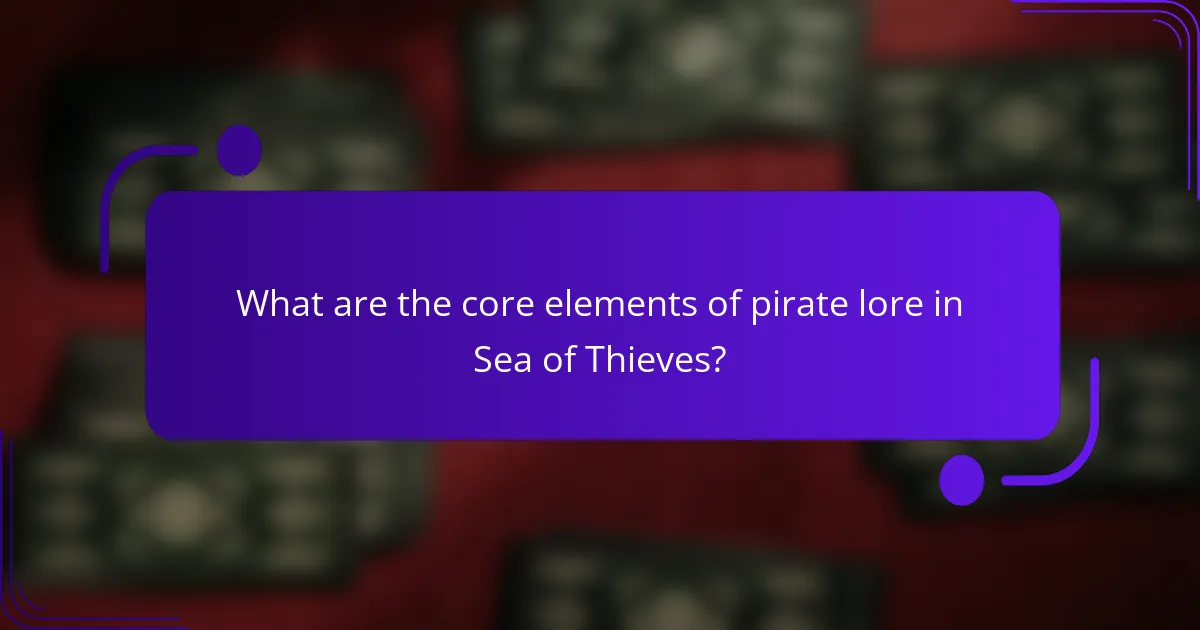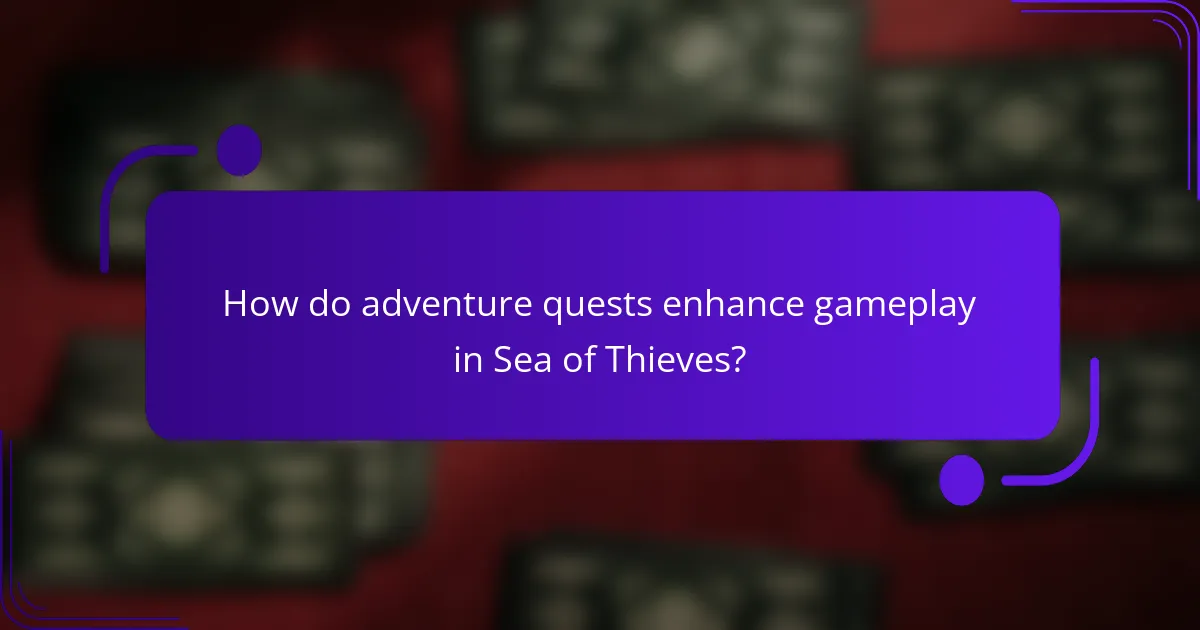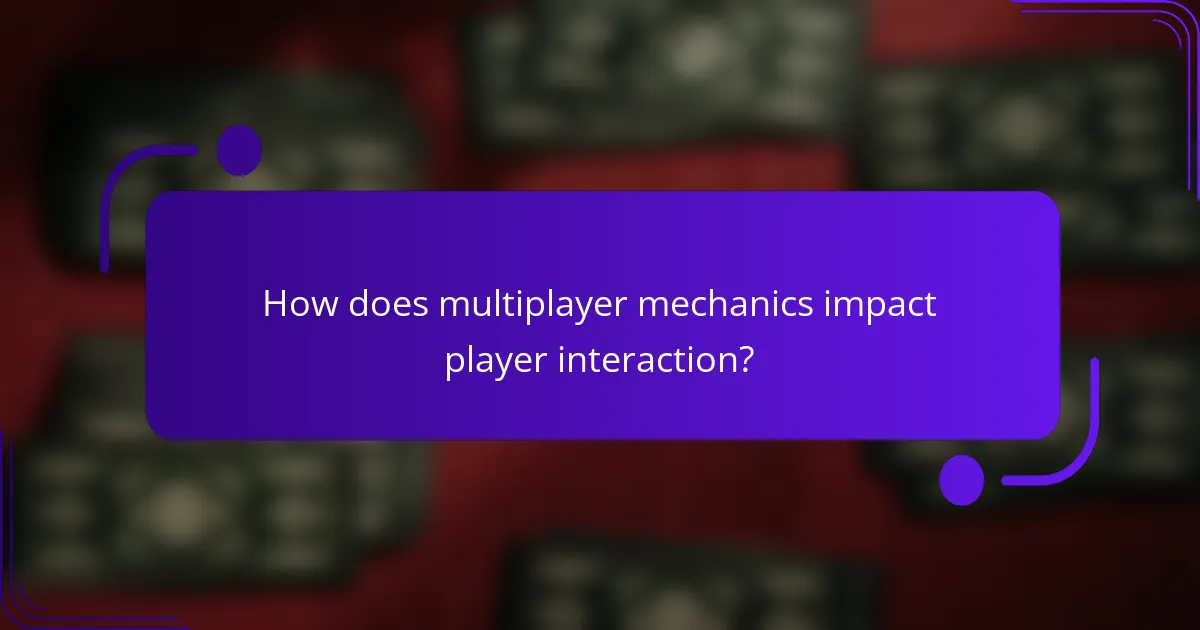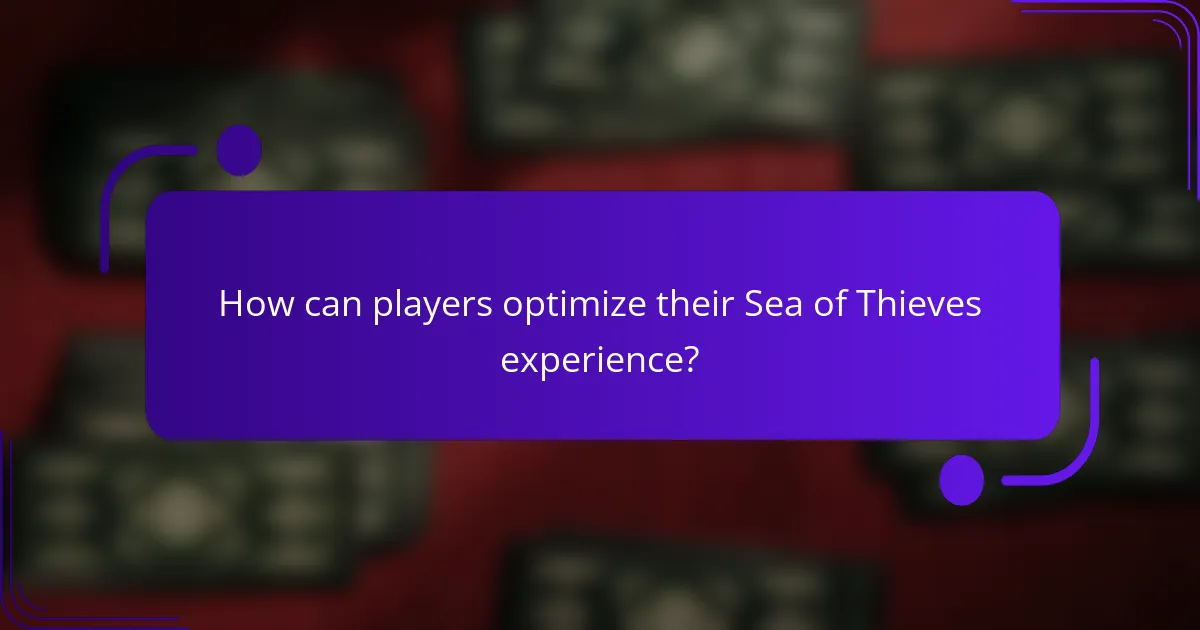Explore the captivating world of Sea of Thieves, where immersive pirate lore, dynamic adventure quests, and engaging multiplayer mechanics await. Encounter legendary figures and mythical creatures while hunting for treasure. Collaborate with fellow players through cooperative challenges and experience thrilling ship battles. Discover how unique attributes like player-driven storytelling and a dynamic weather system enhance your gaming experience.

What are the core elements of pirate lore in Sea of Thieves?
The core elements of pirate lore in Sea of Thieves include legendary figures, mythical creatures, treasure hunting, and cursed artifacts. Players encounter famous pirates like Captain Flameheart, adding depth to the narrative. Mythical creatures such as the Kraken and Megalodon enhance the adventure element, creating thrilling encounters. Treasure hunting is central, with players seeking buried gold and artifacts, while cursed items introduce unique gameplay mechanics. Together, these elements create an immersive pirate experience that defines Sea of Thieves.
How do legendary pirates shape the narrative?
Legendary pirates significantly influence the narrative in “Sea of Thieves” by enriching its lore and enhancing player engagement. Their unique stories and attributes create immersive quests and adventures. Players encounter legendary figures like Captain Flameheart, whose backstory provides context for treasure hunts and conflicts. The allure of these pirates drives multiplayer interactions, as players collaborate or compete to uncover secrets tied to these legendary characters. This dynamic fosters a vibrant community, ensuring that pirate lore remains central to the game’s evolving narrative.
What role do mythical creatures play in the lore?
Mythical creatures in Sea of Thieves enhance the game’s lore by enriching its narrative and providing unique challenges. These entities, such as the Kraken and the Megalodon, embody the dangers of the sea and serve as focal points for adventure quests. Their unique attributes, like the Kraken’s ability to drag ships underwater, create memorable multiplayer experiences. Additionally, these creatures often symbolize the mysteries of the ocean, drawing players into a world filled with legends and folklore.
Which historical references influence the game’s storytelling?
Historical references in Sea of Thieves draw from various pirate legends and maritime lore. The game’s storytelling incorporates elements from classic literature, such as Robert Louis Stevenson’s “Treasure Island,” and historical figures like Blackbeard. These influences shape the game’s quests and character development, enhancing the immersive experience. Additionally, the rich tapestry of pirate myths contributes to the unique attributes of adventure and exploration within the game, appealing to players’ sense of adventure.

How do adventure quests enhance gameplay in Sea of Thieves?
Adventure quests enhance gameplay in Sea of Thieves by providing immersive narratives and cooperative challenges. These quests encourage teamwork, allowing players to strategize and share resources. Unique rewards, such as rare loot and cosmetics, motivate exploration and engagement. Additionally, they deepen the game’s lore, enriching the overall experience and fostering community interactions.
What types of quests are available for players?
Players can engage in various quest types in Sea of Thieves, including Adventure Quests, Tall Tales, and World Events. Adventure Quests focus on exploration and treasure hunting, while Tall Tales offer narrative-driven experiences with unique lore. World Events involve player participation in large-scale battles or cooperative challenges. Each quest type enhances gameplay through different objectives and rewards, enriching the pirate adventure experience.
How do quest difficulties vary across regions?
Quest difficulties in Sea of Thieves vary significantly across regions, influenced by enemy types and environmental challenges. For example, quests in the Shores of Plenty often feature moderate difficulty, while those in the Devil’s Roar present higher stakes due to volcanic activity and aggressive foes. The game encourages players to adapt their strategies based on region-specific attributes, enhancing the overall adventure experience.
What are the rewards for completing quests?
Completing quests in Sea of Thieves rewards players with gold, experience points, and unique items. Gold can be used to purchase cosmetics and upgrades, while experience points contribute to leveling up and unlocking new gameplay features. Unique items may include special weapons, outfits, and titles that enhance the pirate’s identity. Additionally, completing quests fosters teamwork and enhances the overall adventure experience, encouraging players to explore the game’s rich lore and mechanics.

How does multiplayer mechanics impact player interaction?
Multiplayer mechanics significantly enhance player interaction in Sea of Thieves by fostering collaboration and competition. Players engage in cooperative tasks, such as completing quests and sailing together, which builds camaraderie. Competitive elements, like ship battles, create tension and excitement, driving players to strategize and communicate effectively. Unique attributes, such as the game’s open-world design, encourage spontaneous encounters, further enriching player interactions. As a result, the dynamic nature of multiplayer mechanics shapes a vibrant community experience.
What are the benefits of cooperative gameplay?
Cooperative gameplay in Sea of Thieves enhances player experience through teamwork, strategy, and shared rewards. Players can tackle complex quests together, leading to more engaging adventures. Collaboration fosters communication skills and strengthens friendships, making the game enjoyable. Additionally, cooperative play allows for the sharing of resources and skills, maximizing efficiency in completing tasks. Team dynamics create unique gameplay scenarios, enriching the overall experience.
How do alliances affect game strategy?
Alliances significantly enhance game strategy in Sea of Thieves by fostering collaboration among players. Forming alliances allows crews to share resources, coordinate attacks, and complete quests more efficiently. This teamwork can lead to greater rewards and a more enjoyable gaming experience. Additionally, alliances can create dynamic interactions with rival crews, influencing combat tactics and negotiation opportunities. Overall, strategic alliances can be a game-changer in achieving objectives and navigating the game’s challenges.
What challenges arise in competitive multiplayer scenarios?
Competitive multiplayer scenarios in Sea of Thieves present challenges such as teamwork dynamics, resource management, and player aggression. Effective communication is essential for coordinating strategies and navigating conflicts. Resource scarcity can lead to intense competition for loot, heightening tension among crews. Additionally, player interactions can vary from cooperative alliances to hostile encounters, impacting the overall experience.

Which unique attributes define the Sea of Thieves experience?
The unique attributes defining the Sea of Thieves experience include immersive pirate lore, dynamic adventure quests, and engaging multiplayer mechanics. These elements create a rich environment for exploration and teamwork.
Immersive pirate lore encompasses a vast narrative filled with legends, mythical creatures, and hidden treasures. Dynamic adventure quests offer players varied challenges, from treasure hunts to ship battles, enhancing replayability. Engaging multiplayer mechanics facilitate cooperation and competition among players, fostering a vibrant community.
Additionally, the game features a unique attribute: player-driven storytelling, where each player’s actions shape their personal adventures. This aspect sets Sea of Thieves apart from other multiplayer games.
How does player customization influence gameplay?
Player customization significantly enhances gameplay in Sea of Thieves by allowing individual expression and strategic advantages. Players can tailor their pirate’s appearance, which fosters a sense of identity and personal connection to the game. This customization influences social interactions, as unique designs can attract attention and spark conversations among players. Furthermore, specific cosmetic choices can impact gameplay indirectly, as players may choose gear that reflects their playstyle, such as stealthy or aggressive approaches. The depth of customization adds layers to the multiplayer experience, encouraging creativity and enhancing player engagement.
What are the special events that occur within the game world?
Special events in “Sea of Thieves” include seasonal updates, unique quests, and community challenges. These events introduce limited-time content, special rewards, and often enhance multiplayer interactions. For example, the “Festival of Giving” features festive quests and exclusive items. Additionally, the “Ashen Winds” event allows players to battle powerful foes for rare loot. Each event enriches the game world, promoting player engagement and exploration.

What rare attributes contribute to the game’s uniqueness?
Rare attributes that contribute to the uniqueness of Sea of Thieves include its dynamic weather system, player-driven economy, and emergent storytelling. The weather system affects gameplay, creating unpredictable challenges. The player-driven economy allows for unique trading experiences, enhancing immersion. Emergent storytelling results from player interactions, leading to unexpected adventures. These elements combine to create a distinctive pirate experience.
How do limited-time content updates enhance player engagement?
Limited-time content updates significantly enhance player engagement in Sea of Thieves by creating urgency and excitement. These updates introduce new quests, lore, and multiplayer mechanics, encouraging players to explore the game actively. By offering exclusive rewards during these events, players feel motivated to participate, fostering a sense of community. Additionally, the ever-evolving nature of the game keeps the content fresh and appealing, ensuring players return regularly for new adventures.
What are the community-driven events that shape player experiences?
Community-driven events in Sea of Thieves significantly enhance player experiences by fostering collaboration and competition. These events include seasonal festivals, treasure hunts, and limited-time challenges that encourage players to engage with each other. For example, the Festival of Giving promotes teamwork through shared quests, while the Arena mode emphasizes competitive gameplay. These events often introduce unique rewards and lore, enriching the game’s narrative and community ties. As a result, players feel a deeper connection to the game and each other, shaping a vibrant pirate community.

How can players optimize their Sea of Thieves experience?
Players can optimize their Sea of Thieves experience by focusing on teamwork, resource management, and mastering game mechanics. Effective communication among crew members enhances coordination during quests. Prioritizing supplies like food and cannonballs ensures readiness for encounters. Understanding ship mechanics, including sailing and combat, elevates gameplay. Engaging in community events and exploring lore deepens immersion.
What best practices should players follow for questing?
Players should prioritize communication, teamwork, and exploration for effective questing in Sea of Thieves. Establishing clear roles within the crew enhances efficiency. Use in-game tools like the compass and map to navigate effectively. Engage with the environment to uncover hidden treasures and lore. Completing quests with a strategic approach maximizes rewards and enriches the adventure experience.
What common mistakes do new players make?
New players in Sea of Thieves often make several common mistakes that hinder their experience. They frequently underestimate the importance of teamwork, leading to ineffective communication and coordination. Another common error is neglecting to manage their ship’s resources, which can result in running out of supplies during critical moments. Additionally, many newcomers fail to pay attention to the map and navigation, causing them to get lost or miss important locations. Lastly, players often engage in unnecessary combat instead of focusing on completing quests and gathering treasure.
How can players effectively collaborate in multiplayer settings?
Players can effectively collaborate in multiplayer settings by communicating clearly, assigning roles, and strategizing together. Effective communication ensures that all team members are aware of objectives and threats. Assigning specific roles, such as navigator or lookout, allows players to utilize their strengths. Collaborating on strategies, like ambush plans or treasure hunting routes, enhances overall gameplay. Additionally, utilizing in-game tools for coordination, such as maps and signals, can improve teamwork.